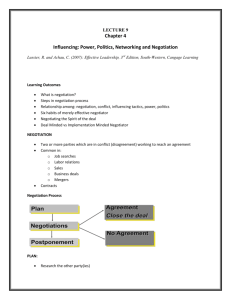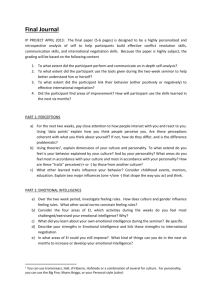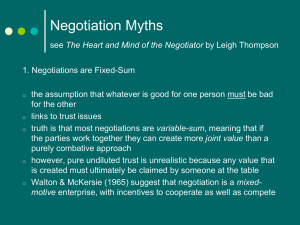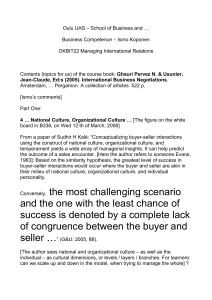Special Issue
advertisement
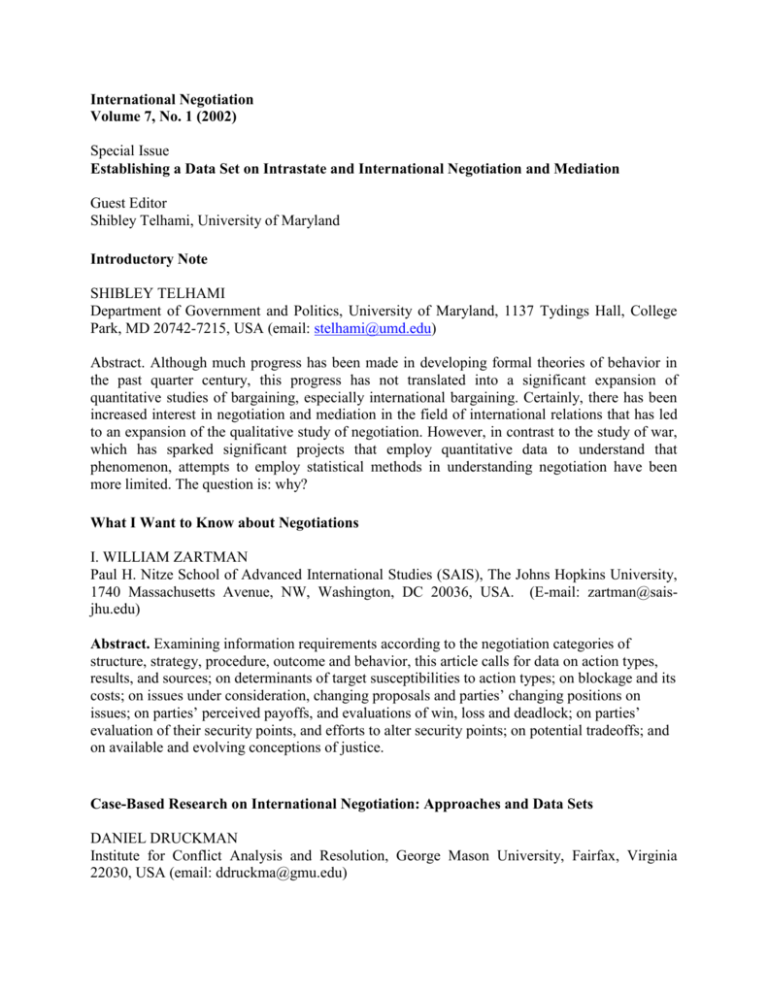
International Negotiation Volume 7, No. 1 (2002) Special Issue Establishing a Data Set on Intrastate and International Negotiation and Mediation Guest Editor Shibley Telhami, University of Maryland Introductory Note SHIBLEY TELHAMI Department of Government and Politics, University of Maryland, 1137 Tydings Hall, College Park, MD 20742-7215, USA (email: stelhami@umd.edu) Abstract. Although much progress has been made in developing formal theories of behavior in the past quarter century, this progress has not translated into a significant expansion of quantitative studies of bargaining, especially international bargaining. Certainly, there has been increased interest in negotiation and mediation in the field of international relations that has led to an expansion of the qualitative study of negotiation. However, in contrast to the study of war, which has sparked significant projects that employ quantitative data to understand that phenomenon, attempts to employ statistical methods in understanding negotiation have been more limited. The question is: why? What I Want to Know about Negotiations I. WILLIAM ZARTMAN Paul H. Nitze School of Advanced International Studies (SAIS), The Johns Hopkins University, 1740 Massachusetts Avenue, NW, Washington, DC 20036, USA. (E-mail: zartman@saisjhu.edu) Abstract. Examining information requirements according to the negotiation categories of structure, strategy, procedure, outcome and behavior, this article calls for data on action types, results, and sources; on determinants of target susceptibilities to action types; on blockage and its costs; on issues under consideration, changing proposals and parties’ changing positions on issues; on parties’ perceived payoffs, and evaluations of win, loss and deadlock; on parties’ evaluation of their security points, and efforts to alter security points; on potential tradeoffs; and on available and evolving conceptions of justice. Case-Based Research on International Negotiation: Approaches and Data Sets DANIEL DRUCKMAN Institute for Conflict Analysis and Resolution, George Mason University, Fairfax, Virginia 22030, USA (email: ddruckma@gmu.edu) Abstract. Four case-based research approaches to analysis of data on international negotiation are discussed: the single, analytical case study, the temporal or time-series case study, the focused comparison of a small number of similar cases, and aggregate comparisons of a large number of different cases. The strategies are compared in terms of a number of methodological and substantive features. They are considered as alternative routes to theory development, understood best in relation to each other and best utilized together as part of a multi-method research strategy. The role of frameworks for guiding comparative analyses is discussed in the second part of the article. They are illustrated in conjunction with several multivariate projects involving the coding of variables from a variety of cases. Methods of analysis and findings obtained from these projects are then summarized. These framework-driven comparative analyses are facilitated by the advent of web-based technologies. The new technologies are especially useful for collecting information about cases of negotiation not described in archival publications. The article concludes with challenges that confront the analyst and some gaps that remain to be filled. Creating Data on International Negotiation Strategies, Alternatives and Outcomes JOHN S. ODELL School of International Relations, University of Southern California, Los Angeles, CA 900890043 USA (email: odell@usc.edu) Abstract. If greater efforts could be invested in generating uniform data on the international negotiation process, I would nominate at least three key dimensions for fresh attention: strategies, alternatives, and outcomes. Although these are not the only interesting dimensions, better empirical knowledge about them is surely central. Strategies can be conceived of as sets of observable behavior that vary along a continuum from purely distributive, through mixed, to purely integrative tactics. This continuum could bring greater order to the many ways in which the notion of strategy has been used. A second worthwhile indicator would estimate the value of the party’s best alternative to negotiated agreement and changes in that value. Theoretically, behavior and ultimately outcomes depend critically on the parties’ alternatives outside the talks. Third, I believe negotiation researchers need to place a high priority on pinning down the difference that the process makes, net of other influences, to the outcome. Measuring gains and losses requires first choosing a conceptual reference point for the comparison. Data creation projects such as these would face theoretical and technical dilemmas that would demand careful thought. But if the necessary resources were invested, researchers would be better able to test hypotheses about negotiation on evidence from actual experience, in addition to laboratory evidence. Thoughts on How to Organize a Data Set on Diplomatic Methods of Conflict Management PATRICK M. REGAN Department of Political Science, PO Box 6000, Binghamton University, Binghamton, NY 13902-6000, USA (email: pregan@binghamton.edu) Abstract. At the initial stages of organizing a data generation effort it is useful to think through the theoretical foundations for the data and the range of questions to which the data could be brought to bear. There are four areas where data on diplomatic interventions should prove particularly fruitful: 1) the notion of “ripe moments,” 2) sequencing of escalation and deescalation, 3) differing ideas about the outcome of diplomatic efforts, and 4) capturing the process of negotiation. A theoretical construct is discussed that can guide the generation of data on negotiations and point toward operational indicators of negotiation consistent with these constructs. Of particular importance, moreover, is a coherent focus on the outcome of the process to be recorded. There is considerable merit in designing a data set that allows testing of ideas about how diplomacy works. In effect, organizing a data generation effort in a manner that captures the essence of the bargaining process (concessions, ideal points, reservation points, etc.) can greatly enhance our knowledge of conflict management. Negotiating Data: Reflections on the Qualitative and Quantitative Analysis of Negotiation Processes P. TERRENCE HOPMANN Watson Institute for International Studies, Brown University, P.O. Box 1970, 111 Thayer Street, Providence, RI, 02912-1970, USA (e-mail: Philip_Hopmann@Brown.edu) Abstract. This article examines the relative advantages and disadvantages of quantitative and qualitative research methods for the analysis of the process and outcome of international negotiations. It does this by tracing the author’s personal evolution as a researcher in the field, indicating how shifting paradigms and changing research questions have created a need for diverse methodologies, each tailored to the specific questions under investigation. It is concluded that large-scale systematic analyses of international negotiations can best be carried out by large interdisciplinary research teams. This will require negotiation scholars to negotiate with one another to develop collaborative research strategies and measurement instruments. If we are to be successful in large-scale, systematic studies of international negotiations, we must emulate our colleagues in fields such as the natural sciences where large teams with substantial resources collaborate over extended periods of time to produce meaningful findings. Concluding Note SHIBLEY TELHAMI Department of Government and Politics, University of Maryland, 1137 Tydings Hall, College Park, MD 20742-7215, USA (email: stelhami@umd.edu) Abstract. If John Harsanyi’s optimism in the 1970s about the use of quantitative analysis in the study of bargaining was driven by the development of formal models that could predict singular outcomes from a given set of assumptions or axioms, some of the articles in this issue indicate that this highly mechanistic approach to negotiations may have been a reason why many students of negotiation, especially international negotiation, have not been attracted to the employment of quantitative analysis. It is obvious that most of our contributors place high value on the process of negotiations, as well as their structure. As P. Terrence Hopmann puts it in his personal essay, “all of my work has been based on the assumption that the process of negotiation does indeed make a difference; that a given set of initial conditions will not regularly produce the same outcome, so that outcomes are affected not only by initial conditions but by the process variables that intervene.” This emphasis on the process of negotiations is especially shared by I. William Zartman. Paradiplomacy: Reflections on the Foreign Policy and International Relations of Regions ANDRÉ LECOURS Department of Political Science, Concordia University, 1455 DeMaisonneuve Blvd. W., Montreal, Quebec H3G lM8, Canada (email: alecours@magma.ca) Abstract. The study of paradiplomacy, concerning the international activity of regional governments, opens the door to a new set of actors and issues for international negotiations. A theoretical framework based in historical institutionalism and neo-realism is established and several examples of paradiplomatic activity are described. The article reflects on these new international actors, external-internal linkages, and expanding the boundaries of the field of international relations and negotiation. The Philosophy and Methodology of Ambassador Dennis Ross as an International Mediator BRIAN BEBCHICK 141 Park Avenue, Passaic, NJ 07055, USA Abstract. This article explores the mediation efforts of Ambassador Dennis Ross, who served for a decade as a key facilitator in the delicate and difficult peace negotiations between Israel and the Palestinians. The salient elements of Ross’s mediation techniques, as applied in a variety of situations, are described and assessed in this case study. Ross’s techniques are divided into nine categories: empathizing, building trust, creating movement, disaggregating issues and symbols, generating creative options, using deadlines effectively, equalizing a power imbalance, establishing confidentiality, and being a fair broker. Ross’s uses of these methods provide valuable insights into the conduct of high-stakes intervention in complex international disputes. Both the requisites and limits of such international intervention are explored, and Ross’s approach is compared with those advocated by scholars in the field. Finally, the article examines why the American effort failed to capitalize upon a series of interim agreements to achieve a final settlement. While Ross is a self-described intuitive mediator, his methods merit careful study, as most are of general utility and application.





